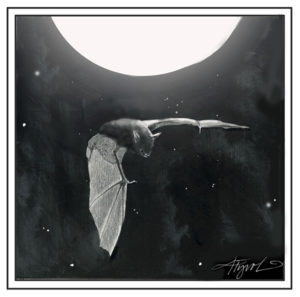By Susan Shea
Years ago, I visited two Vermont caves in winter to help biologists count hibernating bats. After descending through a hole into the first cave, I immediately noticed that it was much warmer than above-ground. The cave was also more humid, and I could hear the steady drip of water. We walked quietly into the darkness and shone our lights at the cave roof. Bats hung upside down singly and in clusters, wings wrapped around furry bodies and feet clinging to the ceiling. These bats would spend the entire winter immobile, except for brief periods of arousal, when they might change position in the cave.

Northeastern bats are insect-eaters, so when flying insects disappear in fall, bats must either migrate or hibernate. Three of our region’s nine bat species are classified as tree bats, because they roost in trees in summer. These include the eastern red bat, hoary bat, and silver-haired bat, which migrate to the southeastern U.S. and Central and South America, where they hunt insects, according to Alyssa Bennett, small mammals biologist with the Vermont Dept. of Fish & Wildlife. If temperatures there drop below 50 degrees and insects become scarce, the bats may go into torpor (a temporary decrease in physiological activity) and burrow into the leaf litter until conditions improve.
Cave bats, conversely, spend winters hibernating in caves, mines, and buildings. They include the little brown bat, big brown bat, northern long-eared bat, tricolored bat, eastern small-footed bat, and Indiana bat. During hibernation, a bat’s body temperature, metabolism, and breathing rate decrease. It is critical that bats not be disturbed during this time, as they can use up precious fat reserves if aroused. The stable temperatures of a cave (ranging from 35 to 50 degrees) and high humidity (over 80%) protect bats from freezing and dehydrating.
To prepare for hibernation, in late summer and early fall, cave bats gather at their hibernacula in an event known as swarming. Individuals repeatedly circle, dive, chase other bats, and land. Scientists don’t completely understand swarming, but believe it may help teach young bats the location of hibernacula. Mating takes place at this time, although females store the males’ sperm and delay ovulation and fertilization until spring, when insects are plentiful. After swarming, bats continue to hunt and fatten up prior to hibernation.
In Vermont, bats enter hibernacula in September to late October. Some travel long distances to find suitable hibernating sites. One southern Vermont cave serves as a regional hibernaculum, including bats that spend summers in other areas of Vermont, as well as Rhode Island and Connecticut.
Populations of cave bats have plummeted in the past 15 years, due in large part to white-nose syndrome, a fungal disease that thrives in caves and is named for the white fuzz victims often exhibit on their faces. First discovered in a New York cave in 2006, the disease damages bats’ wings and causes bats to become active in winter, burning through the fat reserves they need to survive. Bats with white-nose syndrome may even fly outdoors in daytime when temperatures are below freezing.
White-nose syndrome has killed over 90%t of the populations of little brown bat (formerly our most common bat), northern long-eared bat, and tricolored bat in the Northeast. These species, as well as the Indiana bat, and in some states the eastern small-footed bat, are now listed as endangered. Other bat species have fared better. For example, the big brown bat has been somewhat resistant to white-nose syndrome, probably due to its large size and because these bats sometimes hibernate in buildings.
Recently there has been more hope for bats. Bennett reports that the population of little browns has stabilized in Vermont, and some sites have shown modest increases. In Maine, citizen reports of bat sightings increased this past summer, and researchers have discovered bats overwintering under talus slopes in coastal areas. These small hibernacula may be protecting some bats from white-nose syndrome. A Rutgers University-led study found that bats that survived white-nose may have more genetic immunity than those that died; researchers detected differences in these bats in the DNA of genes related to metabolism and hibernation.
“The fate of bats rests almost entirely on people,” says Bennett. Humans can help bats by protecting underground hibernation sites and maternity colonies in buildings, staying out of caves in winter, and by cleaning gear after visiting a cave to prevent the spread of white-nose syndrome.
Susan Shea is a naturalist, writer, and conservationist based in Vermont. Illustration by Adelaide Murphy Tyrol. The Outside Story is assigned and edited by Northern Woodlands magazine and sponsored by the Wellborn Ecology Fund of the New Hampshire Charitable Foundation: nhcf.org.




